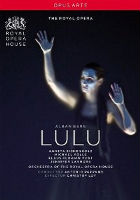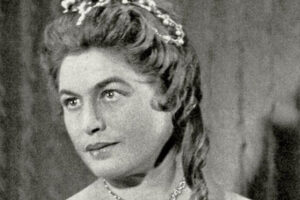
Christof Loy’s highly controversial 2009 production of Berg’s Lulu for The Royal Opera House has been released on DVD (Opus Arte)
, with beautifully realized film direction by Robin Lough. Antonio Pappano and the Orchestra of The Royal Opera House lead an extraordinary cast of singing actors in plumbing the musical and psychological depths of this modern masterpiece.
Lulu has a complex history. Based on two plays by Wedekind, the opera was left incomplete at Berg’s death in 1935, with only fragments of the third act orchestration completed. The composer’s widow Helene Berg is said to have sought Schoenberg to complete the piece, but when he declined, she withheld the original third act sketches and refused to allow another composer to see them. The incomplete version, usually utilizing Berg’s Lulu Suite in place of a third act, was first performed in 1937. It was not until Helene Berg’s death in 1976 that Friedrich Cerha realized the third act; the complete Lulu was first performed in Paris in 1979 with Teresa Stratas in the title role.
This harrowing tale of an irresistible woman who manipulates and is manipulated by the men and women in her life leads inevitably to downfall and destruction, both physically and mentally. Loy’ s minimalist and somewhat modernized production dispenses with period trappings and succeeds wonderfully in focusing our attention on the rich score and on the subtleties of character interaction. The set by Herbert Murauer consists of a black wall bordered with a strip of metal at the bottom; the only furniture a small wooden chair. The extraordinary lighting of Reinhard Traub allows the wall to take on color and dimension, particularly striking when it turns to an icy blue. The costumes (by Murauer and Eva-Mareike Uhlig) are completely monochromatic, entirely in black, white, and shades of grey; the only use of color, tellingly, is red blood; the violent scenes are thus made particularly shocking.
Loy blocks the scenes with singers either facing straight front, in profile, or, when exiting or hiding, turning their backs at the back wall; the stark psychological isolation of the characters is thus made utterly clear. When characters need something from each other, the blocking becomes naturalistic. There are numerous visually stunning moments: when Lulu licks the blood of her Painter husband off the fingers of Dr. Schon, I wanted to avert my eyes in horror, but the moment spoke volumes about the strange need Lulu and Schon have for each other. Later, in another stunner, Lulu “emasculates” Schon by painting his face with her stage make-up; he wears this make-up until his death. Loy manages these moments as part of the storytelling; never do they draw attention to themselves as “effects.”
The cast is uniformly strong. This production was originally to have featured Aleksandra Kurzak in the title role; when she withdrew, Pappano and Loy cast Swedish soprano Agneta Eichenholz. She is indeed a find, and her performance is vocally and dramatically brilliant. A small, beautiful woman (a resemblance to Audrey Hepburn) who moves with a dancer’s grace, Eichenholz manages the treacherous vocal highs and lows of the role with ease and stamina. She is by turns seductive, cold, desperate, touching and vulnerable. Her acting skills are extraordinary. This is a singing actress on the verge of a major career.
Michael Volle is a grounded and powerful Dr. Schon. Jennifer Larmoregives an unusually complex and compelling Countess Geschwitz, vocally lustrous and played with a subtlety that shows no foreshadowing of her recent Norma Desmond-ish Gertrude in Hamlet at the Met. In one of his last roles, Philip Langridge is a brilliantly slimy Marquis, who wants to sell Lulu to a Cairo brothel. Gwynne Howell is a solid, enigmatic Schigolch (though he is the only performer who constantly needs to look at the conductor, breaking up the drama). I found Klaus Florian Vogt (Alwa) to be vocally fine but his performance seemed rather bland.
Pappano’s work with this difficult and complex music was is riveting. He understands, as few do, the romantic side of this opera. The beauty of the piece was never so clear to me, and thus the moments of dissonance were even more interesting. Rarely do a conductor and stage director complement each other’s work as Loy and Pappano do here.
I’m not sure this DVD would make a good choice for a Berg newcomer, but I highly recommend it for those familiar with the work. The skilled film work also enhances the enjoyment; I expect this DVD, which allows us close-up to see tiny details of expression, is a far stronger emotional experience than seeing it in an opera house.

























Comments